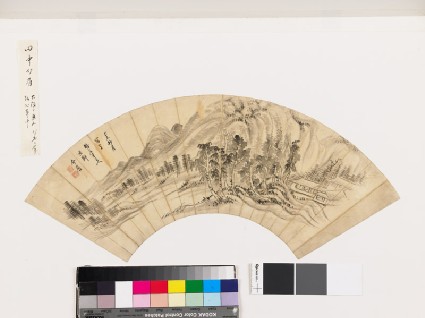Japanese Paintings in the Ashmolean Museum
A catalogue of the Ashmolean's collection of Japanese paintings by Janice Katz (published Oxford, 2003).

Publications online: 43 objects
- Reference URL
Actions
Mountain valley
-
Literature notes
Kaibi has created a sinuous landscape within which a hermitage is ensconced. The busy setting is made up of wavy lines to create the impres¬sion that the hills and mountains are flowing in constant movement. This impression of agitation is reinforced by the short texture strokes used throughout. Several trees reach up underneath the peak of the mountain forming a dramatic focal point to the complex scene.
Mountain Valley is indebted to the painting style of I Fukyū, a Chinese artist who spent time in Nagasaki. [Mount Tiantai of 1742 by Fukyū shows the same kind of dense, fantastic, ever-moving landscape. This is published in Stephen Addiss, ed., Japanese Quest for a New Vision: The Impact of Visiting Chinese Painters, 1600-1900: Selections from the Hutchinson Collection at the Spencer Museum of Art (Lawrence: Spencer Museum of Art, University of Kansas, 1986), 21]. Kaibi was known to be a great collector of Ming and Qing period Chinese paintings, so he could have owned one of the Chinese painter's works or been versed in his style through one of his teachers.
Tanaka Kaibi was a sake merchant born in Osaka but is recorded as having studied under prominent Nanga artists in Kyoto such as Tanomura Chikuden (1777-1835) and Noro Kaiseki (1747-1828). There he became part of a circle of literati that included the proprietor of the Kyūkyodō stationery and art supply shop, as evidenced by this fan. According to the artist’s signature, this image was painted for the head of Kyūkyodō in Kyoto, most likely Kumagai Naoyasu, in the year of his death. -
Details
- Associated place
-
Asia › Japan › Honshū › Kyōto prefecture › Kyoto (place of creation)
- Date
- 1859
- Artist/maker
-
Tanaka Kaibi (born 1814, active 1844 - 1886) (artist)style of Yi Fujiu (c. 1698 - c. 1747) (artist)
- Associated people
-
probably Kumagai Naoyasu (1783 - 1859) (recipient)
- Material and technique
- ink on paper
- Dimensions
-
mount 40.5 x 55.5 cm (height x width)
painting 21.5 x 48.7 cm (height x width)
- Material index
- Technique index
- Object type index
- No. of items
- 1
- Credit line
- Purchased with the assistance the Higher Studies Fund, the Victoria and Albert Museum Fund, and with donations from the friends of P. C. Swann, 1966.
- Accession no.
- EA1966.102
-
Further reading
Katz, Janice, Japanese Paintings in the Ashmolean Museum, Oxford, with an introductory essay by Oliver Impey (Oxford: Ashmolean Museum, 2003), no. 8 on p. 60, p. 39, illus. pp. 60-61
Location
-
- currently in research collection
Objects are sometimes moved to a different location. Our object location data is usually updated on a monthly basis. Contact the Jameel Study Centre if you are planning to visit the museum to see a particular object on display, or would like to arrange an appointment to see an object in our reserve collections.
Publications online
-

Japanese Paintings in the Ashmolean Museum
Kaibi has created a sinuous landscape within which a hermitage is ensconced. The busy setting is made up of wavy lines to create the impres¬sion that the hills and mountains are flowing in constant movement. This impression of agitation is reinforced by the short texture strokes used throughout. Several trees reach up underneath the peak of the mountain forming a dramatic focal point to the complex scene.
Mountain Valley is indebted to the painting style of I Fukyū, a Chinese artist who spent time in Nagasaki. [Mount Tiantai of 1742 by Fukyū shows the same kind of dense, fantastic, ever-moving landscape. This is published in Stephen Addiss, ed., Japanese Quest for a New Vision: The Impact of Visiting Chinese Painters, 1600-1900: Selections from the Hutchinson Collection at the Spencer Museum of Art (Lawrence: Spencer Museum of Art, University of Kansas, 1986), 21]. Kaibi was known to be a great collector of Ming and Qing period Chinese paintings, so he could have owned one of the Chinese painter's works or been versed in his style through one of his teachers.
Tanaka Kaibi was a sake merchant born in Osaka but is recorded as having studied under prominent Nanga artists in Kyoto such as Tanomura Chikuden (1777-1835) and Noro Kaiseki (1747-1828). There he became part of a circle of literati that included the proprietor of the Kyūkyodō stationery and art supply shop, as evidenced by this fan. According to the artist’s signature, this image was painted for the head of Kyūkyodō in Kyoto, most likely Kumagai Naoyasu, in the year of his death.
Notice
Object information may not accurately reflect the actual contents of the original publication, since our online objects contain current information held in our collections database. Click on 'buy this publication' to purchase printed versions of our online publications, where available, or contact the Jameel Study Centre to arrange access to books on our collections that are now out of print.
© 2013 University of Oxford - Ashmolean Museum

